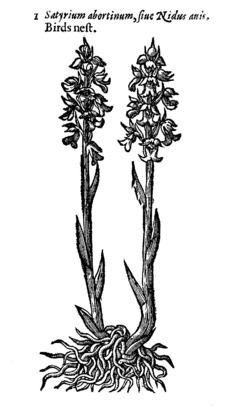
Gerard's Herbal Vol. 1

Fig. 387. Bird's Nest.
The Description.
Bird's Nest hath many tangling roots plaited or crossed one over another very intricately, which resembleth a crow's nest made of sticks; from which riseth up a thick soft gross stalk of a brown colour, set with small short leaves of the colour of a dry oaken leaf that hath lain under the tree all the winter long. On the top of the stalk groweth a spiky ear or tuft of flowers, in shape like unto Maimed Satyrion, whereof doubtless it is a kind. The whole plant, as well sticks, leaves, and flowers, are of a parched brown colour.
I received out of Hampshire from my often remembered friend Master Goodyer this following description of a Nidus avis found by him the twenty-ninth of June, 1622.
Nidus avis flore & caule violaceo purpureo colore; an Pseudoleimodoron Clus. Hist. Rar. plant. pag. 270.
This riseth up with a stalk about nine inches high, with a few small narrow sharp pointed short skinny leaves, set without order, very little or nothing at all wrapping or inclosing the stalk; having a spike of flowers like those of Orobanche, without tails or leaves growing amongst them: which fallen, there succeed small seed-vessels. The lower part of the stalk within the ground is not round like Orobanche, but slender or long, and of a yellowish white colour, with many small brittle roots growing underneath confusedly, wrapped or folded together like those of the common Nidus avis. The whole plant as it appeareth above ground, both stalks, leaves, and flowers, is of a violet or deep purple colour. This I found wild in the border of a field called Marborne, near Habridge in Holybourne, a mile from a town called Alton in Hampshire, being the land of William Baden. In this place also groweth wild the thistle called Corona fratrum. Joh. Goodyer.
The Place.
This bastard or unkindly Satyrion is very seldom seen in these Southerly parts of England. It is reported, that it groweth in the North parts of England, near unto a village called Knaresborough. I found it growing in the middle of a wood in Kent two miles from Gravesend, near unto a worshipful gentleman's house called Master William Swan, of Houk Green. The wood belongeth to one Master John Sidley: which plant I did never see elsewhere; and because it is very rare, I am the more willing to give you all the marks in the wood for the better finding it, because it doth grow but in one piece of the wood: that is to say, the ground is covered all over in the same place near about it with the herb Sanicle, and also with the kind of Orchis called Hermaphroditica, or Butterfly Satyrion.
The Time
It flowereth and flourisheth in June andAugust. The dusty or mealy seed (if it may be called seed) falleth in the end of August but in my judgement it is an unprofitable or barren dust, and not any seed at all.
The Names.
It is called Satyrium abortirum: of some, Nidus avis: in French Nid d'oiseau: in English, Bird's-nest, or Goose-nest: in Low Dutch, Vogels nest: in High-Dutch, Margen dzehen.
The Temperature and Virtues.
It is not used in physic that I can find in any authority either of the ancient or later writers, but is esteemed as a degenerate kind of Orchis, and therefore not used.
END OF BOOK I